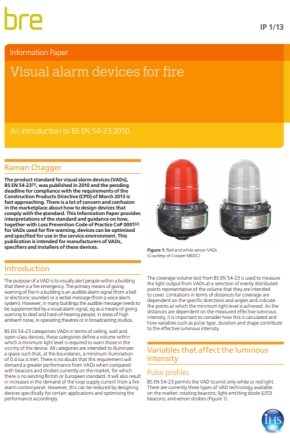Visual alarm devices for fire: An introduction and guide to BS EN 54-23
BRE (Building Research Establishment) is an independent, research-based consultancy, testing and training organisation, operating in the built environment and associated industries.
On 28 February 2012, BRE published Visual alarm devices for fire: An introduction and guide to BS EN 54-23.
The purpose of a visual alarm device (VAD) is to visually alert people within a building that there is a fire emergency. The primary means of giving warning of fire in a building is an audible signal (from a bell or electronic sounder) or a verbal message (from a voice alarm system). However, in many buildings the audible message needs to be supplemented by a visual alarm signal, eg as a means of giving warning to deaf and hard-of-hearing people, in areas of high ambient noise, in operating theatres or in broadcasting studios.
The product standard for VADs, BS EN 54-23, was published in 2010 and the deadline for compliance with the requirements of the Construction Products Directive (CPD) was March 2013. This Information Paper provides interpretations of the standard and guidance on how, together with Loss Prevention Code of Practice CoP 0001 for VADs used for fire warning, devices can be optimised and specified for use in the service environment.
This 12-page publication is intended for manufacturers of VADs, specifiers and installers. Its contents are:
- Introduction.
- Variables that affect the luminous intensity.
- The coverage volume test.
- Testing and approvals for VADs.
- Codes of practice for VADs.
- Conclusions.
- References.
Ref https://www.brebookshop.com/details.jsp?id=327102
[edit] Related articles on Designing Buildings Wiki
- BRE articles on Designing Buildings Wiki.
- BRE Buzz articles on Designing Buildings Wiki.
- BRE Buzz.
- BREEAM.
- Building Research Establishment.
- Visual alarm devices - their effectiveness in warning of fire.
- Automatic fire detection and alarm systems, an introductory guide to components and systems BR 510.
- Evacuating vulnerable and dependent people from buildings in an emergency FB 52.
- Fire detection and alarm system.
- Fire detector.
- Fire.
- Heat alarm.
- Ionisation smoke alarms.
- Optical smoke alarm.
- Personal protection watermist systems in the homes of vulnerable people.
- Smoke detector.
- The causes of false fire alarms in buildings.
- Understanding the factors affecting flashover of a fire in modern buildings.
Featured articles and news
CIOB report; a blueprint for SDGs and the built environment
Pairing the Sustainable Development Goals with projects.
Latest Build UK Building Safety Regime explainer published
Key elements in one short, now updated document.
UKGBC launch the UK Climate Resilience Roadmap
First guidance of its kind on direct climate impacts for the built environment and how it can adapt.
CLC Health, Safety and Wellbeing Strategy 2025
Launched by the Minister for Industry to look at fatalities on site, improving mental health and other issues.
One of the most impressive Victorian architects. Book review.
Common Assessment Standard now with building safety
New CAS update now includes mandatory building safety questions.
RTPI leader to become new CIOB Chief Executive Officer
Dr Victoria Hills MRTPI, FICE to take over after Caroline Gumble’s departure.
Social and affordable housing, a long term plan for delivery
The “Delivering a Decade of Renewal for Social and Affordable Housing” strategy sets out future path.
A change to adoptive architecture
Effects of global weather warming on architectural detailing, material choice and human interaction.
The proposed publicly owned and backed subsidiary of Homes England, to facilitate new homes.
How big is the problem and what can we do to mitigate the effects?
Overheating guidance and tools for building designers
A number of cool guides to help with the heat.
The UK's Modern Industrial Strategy: A 10 year plan
Previous consultation criticism, current key elements and general support with some persisting reservations.
Building Safety Regulator reforms
New roles, new staff and a new fast track service pave the way for a single construction regulator.
Architectural Technologist CPDs and Communications
CIAT CPD… and how you can do it!
Cooling centres and cool spaces
Managing extreme heat in cities by directing the public to places for heat stress relief and water sources.
Winter gardens: A brief history and warm variations
Extending the season with glass in different forms and terms.
Restoring Great Yarmouth's Winter Gardens
Transforming one of the least sustainable constructions imaginable.

























